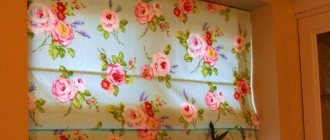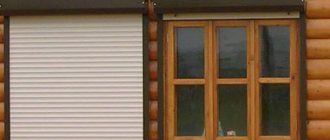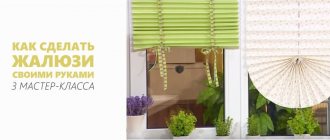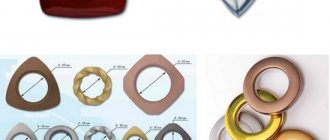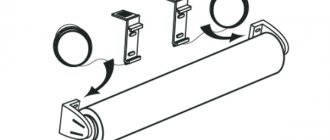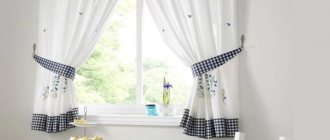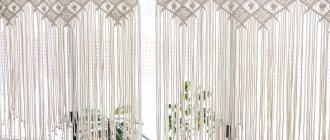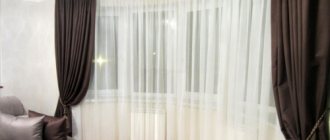Functions of curtain weights
A special weighting device ensures the much-desired evenness of the lines. Japanese, Roman, and Hungarian curtains and drapes made from heavy fabrics are especially susceptible to deformation and do not hold the desired shape without additional load. In order not to be puzzled by the issue of purchasing a finished product, you can make weighting material for curtains with your own hands, getting an effective result in the shortest possible time with minimal investment.
You can make a weighting agent from available items (ribbon, cord, metal parts, slats are suitable). In each specific case, the choice of weighting material is determined by the properties of the fabric. Cord and ribbon are used if the main material of the curtains is tulle, organza or other light fabrics. The remaining options are relevant if the window opening is decorated using heavy materials.
It should be noted that the cords and weights are especially convenient, which can be easily removed before washing or cleaning the curtains.
External weight for weighting
Instead of filling the inside of the curtain with various elements, you can hang a load from the outside. Then weights with various holes, as well as weights, are used.
From available means, such products can be easily replaced with unnecessary worn-out coins. Serially supplied weights are mainly made either round (that’s when holes are needed) or elongated conical parts.
Most often, such designs are sewn into spreads from the sides.
How to make a weighting agent: use cords or ribbons
When making a weighting agent for tulle, you can make a load-creating structure from a ready-made cord or tape, use a piece of wire or a regular chain. A weighting cord for curtains, inserted along the lower border of the fabric, allows you to give the curtains an ideal shape without overloading them at all. Ready-made weights for curtains in the form of a cord can be purchased in several versions, choosing the appropriate weight (from 15 to 150 grams).
If deformations are present only in the area of the corners, a weighting agent for curtains, which has the form of a plate fixed in the hem of the fabric, is suitable. You can purchase ready-made products, choosing the appropriate weight option, or make the plate yourself from thick cardboard or a piece of plastic (if the curtain is made of thick material).
An alternative to a cord or tape can be homemade weights made from a lath purchased at a hardware store or made from a block. This is exactly the option used for Japanese curtains (you can choose plastic, metal or wooden slats attached to the curtain by inserting into pockets on the canvas or gluing).
Weights-cargoes
This type of curtain weight is made using fabric, curtain tape, a needle and thread of the appropriate color, scissors and small metal parts (small furniture fittings, coins or heavy but small buttons are suitable). Before sewing in, the weights are covered with fabric. To sew on the details, preliminary preparation of the bottom edge or side of the curtain is required.
Weights-cargoes
You can correctly determine the weight of such a weighting agent based on the following figures:
- Tulle and lightweight materials - use weights weighing 12-22 grams;
- Medium weight fabric, including linen - weights, all of which do not exceed 50 grams;
- Heavy materials (for example, velvet, satin) - loads weighing more than 51 grams.
We sew ready-made weighting materials: ribbons, slats and cords
Curtain tape, cords and slats can be sewn either manually or using a sewing machine (overlock and zigzag modes). Using tape, the bottom of the curtain is rolled up and secured with a weighting element.
You can sew a weighting cord for curtains or its analogue in the form of a slats in the following way:
- Fold the bottom edge of the curtain. For wooden planks, the space for hemming the bottom pocket should be measured taking into account the height of the plank and a few centimeters added to it.
- Iron the sides of the curtain to the wrong side, secure the hem line on the side with pins and sew on a machine.
- Thread the selected material into the formed pocket.
To sew weighting to organza, the material chosen for balancing is sewn directly to the bottom edge without forming a pocket. Therefore, it is better to sew a weighting cord to the organza, matching it to the color of the curtain. Chains and slats are not applicable in this case.
Another weighting option in the form of a special fringe sheet attached to the bottom is suitable for massive heavy curtains. This solution will look especially appropriate in interiors decorated in a classic or retro style.
If you want to sew on a weighting material, saving your own time and money as much as possible, you can balance the curtains by folding the bottom of the fabric twice to a height of about 10 cm.
Weights
You can sew a weighting material for curtains of this type yourself in the following ways:
- Parts of a suitable size are selected, sewn into pieces of fabric and individually sewn on the wrong side of the drapery or curtain at strictly equal intervals.
- The fabric for wrapping cargo is not divided into pieces, but is left in the form of a single strip of material folded in half, which is stitched to form pockets. Weights are placed in the recesses, after which the strip is sewn to the wrong side of the curtain.
- Use the folded edge of the curtains as places for pockets (this option is suitable if the curtain is of sufficient length).
You can sew curtain weights not along the entire length of the bottom edge, but only on the sides. The improvised parts that replace finished products must be voluminous and at the same time sufficiently small. First, such weights are sheathed with fabric, after which they are inserted into a small incision made on the side of the hem (at a height of at least 5 cm from the edge). If there is no flap on the side, you can secure the loads using curtain tape.
Sew on the weighting material
In conclusion, I would like to note another original weighting option used for light, weightless fabrics. We are talking about volumetric embroidery, which includes various decorative elements. True, creating a weighting agent will require excellent artistic taste and great patience, so it is better to purchase such options ready-made.
Additional Information
Expert opinion
Romanova Ksenia Petrovna
Interior design expert and fabric store manager
Placing them inside cuffs and seams allows you to hide weights from prying eyes. Therefore, the choice of a suitable device is strictly individual.
Almost anything you can pick up will do. Curtains are mainly complemented with plates and cords.
Since these elements have an external part, it is very important that they complete the composition and bring it to perfection.
When it is planned to maintain the geometry of the curtain only at the corners, a special kind of plate is used. Most often, the delivery kit already includes mounting brackets. Such devices help fix the weighting material in the bottom hem.
For Roman blinds, weighting agents are selected in the form of:
Particular attention should be paid to the selection of weights mounted on bath curtains. In this case, only a steel chain is suitable; occasionally it is replaced with rods and small balls. Another option is several magnets. This solution is optimal for a steel or cast iron bathtub. If it is made of other materials, it will not fit well.
How to hem tulle with weighting is described in the video below.
The calling of curtain weights
Initially, curtain weights were invented for light and weightless fabrics in order to create weight, presentability, an even and aesthetic appearance of the curtain product.
In the production of light curtain fabric, the most popular weighting material is used in the form of a cord, inside of which lead weights are sewn. This cord is industrially overlaid along the bottom of the fabric throughout the entire roll.
Curtain weights
There is some opinion that the weighting for curtains on light fabrics should be cut off. And, of course, further, not as a slogan, but as a recommendation:
- Industrial curtain weights are designed to WEIGHT your curtains. With it, draperies look more advantageous, falling effectively and equally over the entire height of the product.
- If you don’t like the bottom edge from an aesthetic point of view, then cut off the weighting and thread it into an even and neat hem along the bottom of the tulle.
- The most economical options for lightweight fabrics are not equipped with weighting agents. What to do in this case?
- Buy curtain weights for a cut. The width of the fabric is equal to the required length of the weighting material for the curtains.
Characteristics and purpose of using weighting materials
Even heavy curtains are not stable and are easily moved by the wind. To fix the curtains in one place, special weights are provided. Such devices have different weights, thicknesses, and modifications.
A special weighting device ensures the much-desired evenness of the lines.
Important! When choosing a weighting agent, you need to rely on the density of the fabric. The higher it is, the greater the mass of the element used should be.
Which curtain models need additional load.
- Roman. Curtains have a mechanism that lifts the fabric and rolls it onto the curtain rod. The design is additionally equipped with a wooden or plastic slats.
- Japanese. These are fabric sheets that are weighted with metal, wood or plastic slats. They are secured with glue.
- Curtains in the bathroom. Small magnets or plastic parts are used as weights to prevent deformation of the waterproof fabric.
- Tulle. Lightweight sheer fabric can only be finished with lace.
- Heavy curtains. Here it is recommended to use metal balls and cylinders.
You can make a weighting agent from available items (ribbon, cord, metal parts, slats are suitable).
In each specific case, the choice of weighting material is determined by the properties of the fabric.
The weighting material allows you to maintain the necessary shape of the curtains and prevents the curtains from deforming. In addition, this detail helps to quickly straighten the curtains. Thanks to a small load, the tulle will always look neat.
Cord and ribbon are used if the main material of the curtains is tulle, organza or other light fabrics.
How to cut and shorten tulle evenly if it is long?
Nowadays, more and more buyers do not trim curtains, but use a variety of hems. This will allow you to rip off the tape and lengthen the curtains if necessary. But if you do not want to do this, it is advisable to shorten the tulle after it has hung on the curtain rod for 3 days. In this case, the canvas is completely straightened.
Instructions:
- Once your curtains have hung, you can trim them.
- To do this, it is worth considering the features of your room. Often the floor and ceiling are curved, which is why the height of the room is different at certain points.
- In this case, it is worth noting the height at the beginning, at the end and in the middle. After that, print the average value.
- It is advisable to draw a line using a ruler. Often curtains are cut using a stationery knife.
- To do this, the ruler is placed on the curtain and drawn with a knife.
How to cut and shorten tulle evenly if it is long?
Types of weights
Some curtains are sold immediately with weighting. Typically, such a detail takes the form of a small dense strip of fabric at the end of the curtains. If such an element is not provided, then over time the tulle may curl and bend. To prevent this process, it is recommended to sew the weight yourself.
It should be noted that the cords and weights are especially convenient, which can be easily removed before washing or cleaning the curtains.
- cords;
- chain;
- plates;
- wooden slats and planks;
- steel tube;
- metal pins;
- wires;
- weights.
When making a weighting agent for tulle, you can make a load-creating structure from a ready-made cord or tape, use a piece of wire or a regular chain.
For light curtains and tulle, it is better to choose a cord. This element should be sewn to the bottom of the curtains. The cord is almost invisible, so it is actively used to weigh down transparent fabrics. The parts vary in weight and thickness.
The optimal size is selected depending on the density of the curtains.
You can purchase ready-made metal weights. The market offers devices weighing from 10 to 150 grams. They are round, cylindrical, flat. The weight can be sewn into a special pocket or secured to the outside of the curtains.
Ready-made weights for curtains can be purchased in several versions, choosing the appropriate weight.
If the curtains begin to change shape at the corners, then you need to use plates. They differ in shape and weight, and are easily attached to the canvas. Planks are often used to secure the sides to create the correct angle.
The plate can be easily removed if you need to wash the curtains or transport them.
You can make the plate yourself from thick cardboard or a piece of plastic.
If you don’t have the desire or means to purchase ready-made factory weights, you can make curtain weights with your own hands. You will need to prepare the wire and secure it at the bottom of the curtains, after tucking the fabric. For Roman curtains, it is allowed to use a lace or chain.
Possible modifications
There are weights in the form of tape or oblong weights. There are also options with a cord and based on round elements with holes.
All types differ in their specific area of application. But the desired loads are not always included in the delivery of curtains.
When making an additional purchase, difficulties may be associated with an inflated price or even a complete lack of goods on sale.
Weighting parts can be made by hand. The simplest of them are sewn into the lower edges of curtains. Cords are also used when sewing light curtains and tulle. A good replacement for them are steel chains or pieces of thin wire. Rail-type weights are inserted into the folded edges of the curtains.
You need to sew on the slats:
- manually;
- on a sewing machine (using a zigzag seam);
- on an overlocker.
A simple fold of the bottom edge of the curtain and pulling the chain through in the case of opaque material looks pretty good. But this option is not suitable when the curtain is made of transparent fabric. Then weighting them with their own canvas comes to the rescue. The technique is very simple: fold the edge from below twice by 100 mm.
The following can also be used to replace the tape:
- wooden slats;
- thin steel tubes;
- metal pins.
Methods for attaching weights
If you wish, you can sew your own curtains with additional weights. A load, fabric to match the color of the curtains, a sewing machine, threads, and scissors are prepared in advance. Measurements are taken with a measuring tape or tape measure. The method of attaching coins or wire depends on the weight of the web.
Tulle and lightweight materials - use weights weighing 12-22 grams.
The sequence of internal fastening of the weighting material to the lightweight fabric:
- If the curtain is light in weight, it is recommended to sew the strips on the sides. It is enough to take 2 parts weighing no more than 22 grams.
- Each element must be placed in a fabric pocket, which is sewn separately.
- A small cut should be made on the back side of the bottom hem of the curtain, keeping an interval of 5 cm from the bottom. If the material is not tucked, then it is allowed to use curtain tape.
- A pocket with a weighting agent is inserted into the resulting cut and sewn to the curtain.
To insert the parts, preliminary preparation of the bottom edge or side of the curtain is required.
When the curtain is made of dense, heavy material, the weight needs to be sewn in in a different way. On the reverse side at the bottom there are several pockets into which coins or metal balls are inserted. The folded bottom of the curtain can serve as a place for placing the parts.
Curtain tape is sewn to cover the holes. It is important to secure the weights so that they do not fall out when the curtain is in an upside-down position. To fix a wire or chain, you first need to fold the fabric 10 cm and stitch it. A weighting agent is threaded into the resulting hole.
To prevent the load from shifting, the side edges of the hem are sewn up.
It is not necessary to sew a special pocket to fix the curtains in one position. Frequently, loads are attached to the outside of the curtains. In this case, weights for curtains or products with holes are used. From scrap materials, old coins will come in handy. The bottom of massive curtains is decorated with fringe or pendants, but such a detail is appropriate in classic or retro-style interiors.
Another weighting option in the form of a special fringe sheet attached to the bottom is suitable for massive heavy curtains.
The weighting material on organza curtains does not need to be placed in a special pocket. Here a special cord is used to match the curtains and is sewn on the back side of the fabric. It is prohibited to use chains and slats for curtains made of organza.
To sew weighting to organza, the material chosen for balancing is sewn directly to the bottom edge without forming a pocket.
Weight mounting options
In this case, if you strive to ensure that the curtains always have a neat and attractive appearance, you can fasten the weights in three different ways, namely:
- First of all, you will need to take the necessary measurements. After which, you can wrap each metal part in a small piece of fabric. To ensure that the curtains straighten evenly, it is necessary to use a sufficient number of metal parts wrapped in fabric. The parts should be placed evenly from below on the canvases. Each weight is sewn separately to the wrong side of the curtain.
- The second method does not involve cutting the fabric into equal pieces. Here you will need a single strip of fabric of appropriate sizes. The strip must be folded in half and appropriate pockets must be made into which metal parts will be placed.
You can make either one row of weights or several, it all depends on what kind of load you want to hang on the curtains. The finished strip is sewn to the curtain from the reverse side. It is worth paying special attention so that the weights do not fall out after the strip is sewn onto the curtains.
- The third method is suitable for those who do not strive for excessive hassle and the use of additional fabric. In this case, an additional strip is created by folding the edge of the curtain and evenly distributing pockets for metal parts. The method is quite simple, but it will require attentiveness and accuracy from you, since in this case, all work is done with the curtain fabric, and not with a separate piece of fabric.
- In addition to the three above methods for creating special weights for curtains with your own hands, there is a combined method. It all depends on your decision which methods to combine to achieve the best result.
Recommendations for processing tulle
Classic tulle weights are not used, since the material is translucent and the weight will always be visible. To straighten the lower part and fix transparent curtains, the use of strips, chains, metal products, etc. is not required.
Sew a weighting cord to the organza, matching it to the color of the curtain.
How to sew weights on tulle, step-by-step instructions:
- The bottom needs to be folded twice by 10 cm;
- Then the resulting hem is ironed;
- Then the folded part is stitched manually or on a machine.
Chains and slats are not applicable in this case.
The main mistakes in the process of selecting and sewing weights
The main mistakes when choosing weights for curtains lie in incorrectly selected elements. For light fabrics (chiffon, organza, tulle), it is recommended to use lace. Weighting of roller and Japanese curtains is carried out using plates, slats, and slats. For heavy curtains, coins, oval and round weights are used.
You can sew curtain weights not along the entire length of the bottom edge, but only on the sides.
The main mistakes when choosing and sewing weights:
- incorrectly selected load for the material used;
- using an element that is too heavy or light;
- the hem is too large or small (when choosing the optimal size of the folded fabric, you need to start from the width of the plate, adding a few centimeters in reserve);
- the use of a noticeable plate for transparent fabric, which spoils the appearance of the curtains (for tulle, you only need to use a lace or make a hem);
- the use of metal or wooden products for curtains in the bathroom (steel and wood quickly deteriorate in conditions of high humidity and constant temperature fluctuations, so it is better to use plastic strips).
If there is no flap on the side, you can secure the loads using curtain tape.
For wooden planks, the space for hemming the bottom pocket should be measured taking into account the height of the plank and a few centimeters added to it.
You can purchase a special factory weighting agent or use improvised materials. The main thing is to choose the right load for the material and model of the curtain. Additional details are placed in fabric hems or sewn pockets.
The bottom of the curtain is rolled up and secured with a weighting element.
Peculiarities
No matter how heavy the curtain may seem, it is still easily moved by the air flow. That’s why special weights are needed in many ways to help hold the canvas in place. Weighting elements vary in thickness and weight. There is only one selection rule: the higher the density of the curtain fabric, the heavier the part used should be.
It can be used for:
- Roman curtains;
- Japanese curtains;
- roller blinds;
- Hungarian curtains;
- heavy curtains.
Thanks to the increased load, it is ensured:
- maintaining the required shape;
- accelerated straightening of folded fabric;
- always attractive appearance.
This will help you sew curtain weights with your own hands.
Every housewife strives to bring the interior to perfection. One of the obstacles on the way to the set goal is curtains and curtains that curl at the edges, which cannot be straightened by ironing and steaming. The solution to the problem is curtain weights.
- We sew ready-made weighting materials: tapes, slats and cords. Weights
Functions of curtain weights
A special weighting device ensures the much-desired evenness of the lines. Japanese, Roman, and Hungarian curtains and drapes made from heavy fabrics are especially susceptible to deformation and do not hold the desired shape without additional load. In order not to be puzzled by the issue of purchasing a finished product, you can make weighting material for curtains with your own hands, getting an effective result in the shortest possible time with minimal investment.
You can make a weighting agent from available items (ribbon, cord, metal parts, slats are suitable). In each specific case, the choice of weighting material is determined by the properties of the fabric. Cord and ribbon are used if the main material of the curtains is tulle, organza or other light fabrics. The remaining options are relevant if the window opening is decorated using heavy materials.
It should be noted that the cords and weights are especially convenient, which can be easily removed before washing or cleaning the curtains.
How to make a weighting agent: use cords or ribbons
When making a weighting agent for tulle, you can make a load-creating structure from a ready-made cord or tape, use a piece of wire or a regular chain. A weighting cord for curtains, inserted along the lower border of the fabric, allows you to give the curtains an ideal shape without overloading them at all. Ready-made weights for curtains in the form of a cord can be purchased in several versions, choosing the appropriate weight (from 15 to 150 grams).
If deformations are present only in the area of the corners, a weighting agent for curtains, which has the form of a plate fixed in the hem of the fabric, is suitable. You can purchase ready-made products, choosing the appropriate weight option, or make the plate yourself from thick cardboard or a piece of plastic (if the curtain is made of thick material).
An alternative to a cord or tape can be homemade weights made from a lath purchased at a hardware store or made from a block. This is exactly the option used for Japanese curtains (you can choose plastic, metal or wooden slats attached to the curtain by inserting into pockets on the canvas or gluing).
Weights-cargoes
This type of curtain weight is made using fabric, curtain tape, a needle and thread of the appropriate color, scissors and small metal parts (small furniture fittings, coins or heavy but small buttons are suitable). Before sewing in, the weights are covered with fabric. To sew on the details, preliminary preparation of the bottom edge or side of the curtain is required.
We sew ready-made weighting materials: ribbons, slats and cords
Curtain tape, cords and slats can be sewn either manually or using a sewing machine (overlock and zigzag modes). Using tape, the bottom of the curtain is rolled up and secured with a weighting element.
You can sew a weighting cord for curtains or its analogue in the form of a slats in the following way:
- Fold the bottom edge of the curtain. For wooden planks, the space for hemming the bottom pocket should be measured taking into account the height of the plank and a few centimeters added to it.
- Iron the sides of the curtain to the wrong side, secure the hem line on the side with pins and sew on a machine.
- Thread the selected material into the formed pocket.
To sew weighting to organza, the material chosen for balancing is sewn directly to the bottom edge without forming a pocket. Therefore, it is better to sew a weighting cord to the organza, matching it to the color of the curtain. Chains and slats are not applicable in this case.
Another weighting option in the form of a special fringe sheet attached to the bottom is suitable for massive heavy curtains. This solution will look especially appropriate in interiors decorated in a classic or retro style.
If you want to sew on a weighting material, saving your own time and money as much as possible, you can balance the curtains by folding the bottom of the fabric twice to a height of about 10 cm.
Weights
You can sew a weighting material for curtains of this type yourself in the following ways:
- Parts of a suitable size are selected, sewn into pieces of fabric and individually sewn on the wrong side of the drapery or curtain at strictly equal intervals.
You can sew curtain weights not along the entire length of the bottom edge, but only on the sides. The improvised parts that replace finished products must be voluminous and at the same time sufficiently small. First, such weights are sheathed with fabric, after which they are inserted into a small incision made on the side of the hem (at a height of at least 5 cm from the edge). If there is no flap on the side, you can secure the loads using curtain tape.
In conclusion, I would like to note another original weighting option used for light, weightless fabrics. We are talking about volumetric embroidery, which includes various decorative elements. True, creating a weighting agent will require excellent artistic taste and great patience, so it is better to purchase such options ready-made.
DIY tulle with weights
Modern industry today offers a huge variety of materials for making tulle. Many of them, even at the production stage, are treated on one long side with a so-called weighting agent. In appearance, it is a wide stitch made on an overlocker. Inside it is a textile cord with a kind of steel beads connected together by a common thread.
Treated in this way, the edge of the fabric is pulled down under the weight of the steel elements and holds its shape better. That is why weighting is a fairly common phenomenon today. Processing tulle with a weighting agent with your own hands is not a difficult task, but it has its own specifics.
What will you need?
In order to do all the work yourself, you need to prepare:
- textile;
- curtain tape;
- sewing machine;
- iron for ironing;
- tape measure;
- scissors;
- threads (matched to the color of the curtain).
The curtain tape is selected according to the length of the curtain so that it can be easily sewn on.

